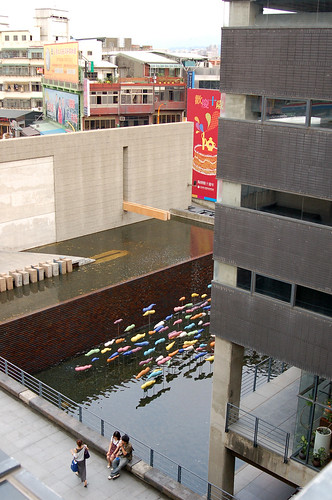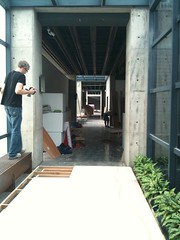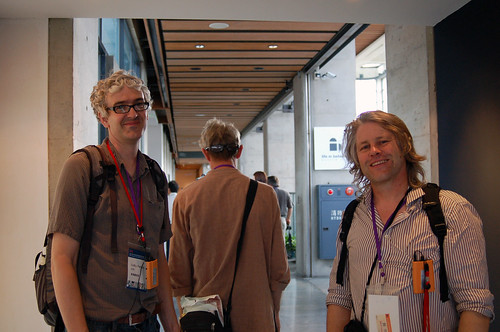Korero is the Maori (indigenous people of New Zealand) word for “conversation”, the main theme of this unique exhibition, appropriately titled, as New Zealand is the home country of curator Ms. Moyra Elliot.
Ok, I could just sit here and re-organize all of the information in the Symposium booklet and the exhibition catalog, which is what that first sentence started to do. Instead, what I’d like to share is my personal experience of the Biennale events. It is one of being simultaneously an outsider and insider. As a resident artist here at YCM (Taipei County Yingge Ceramics Museum, Taiwan) from May until August, I was able to witness aspects of the Biennale that are usually reserved for those directly involved in its production.
The term “resident artist” was a little confusing during this time, as the museum has three different residency programs, which are evolving with every new event and connection within the field of ceramics. My position is offered as part of the education department for emerging artists to provide a culturally unique space to produce a body of work. There were two other resident artists here in the months leading up to this event as part of a new program within the exhibition department that invites artists participating in the Biennale to create their work in the Museum’s studio. Jim Cooper, NZ, has been in Taiwan since December of 2009, and if you take a look at his installation you will understand why. Colby Parsons, Associate Professor of Ceramics at Texas Woman’s University, USA, began his work in the studio about the same time I did. A third artist from Japan, Mr. Satoru Hoshino was also a resident artist, but finished his work before I arrived. Jim was elated to have some English-speaking comrades in the studio, as the robot style English diction required to communicate with the non-native English speakers that surrounded us becomes wearing after a while, to say the least. Not only that, but a seemingly simple request such as, “I need some epoxy resin to bond the parts of my work together. Can you tell me where I can buy this?” turns into a three-day fiasco of translation and scavenger hunting involving at least four more people. Its not that Colby and I could help with the accessibility of tools and materials, but the fact that we could commiserate about the perils of translation in the same mother tongue was paramount, and of great relief to Jim who was probably up to three packs a day by then.
May and June were energetic, filled with lots of making, talking, laughing, and some fun field trips to nearby factories and artist’s studios graciously arranged by Hung, the museum’s director of education. A constantly high blood-caffeine ratio was maintained by numerous tea and coffee breaks which quickly spawned the formation of “The Club”—a little niche outside the studio, next to the waterfall and pond, near the museum kitchen, adjacent to the parking garage. Over the weeks, this little spot morphed from a couple chairs and table put together from some found studio stuff— in a very Mickey Mouse way as Jim would say— into a nearly fully equipped kitchen and lounge (toaster oven, deep wooden drawer forming excellent pantry, cutting board, utensils, water boiler, teapot, coffee pot and maybe a few other IKEA products), complete with wifi (because this happened to be the only spot in the basement of the museum where there was a strong signal), a small serenity tadpole pond, and a shade umbrella. The cleaning staff even started to empty and put a plastic liner in the five-gallon bucket appropriated as a rubbish bin. Thankfully, The Club’s founding fathers, Jim and Colby, decided that girls were allowed, even if they were commuters from Taipei City. Yours truly was pleased, and in July, when Moyra arrived, there was gender equilibrium, and even more interesting conversation and comic relief, which are defining qualities of The Club.
The end of June was expectedly hectic for Jim and Colby as they were not only trying to complete the final firing of their work, but also had to juggle some of the strains of celebrity status here in Yingge. Interviews, press conferences, photography sessions, dinners, and all this while trying to finish and install quite complex works of ceramic art for an international exhibition. Oh, and did I mention that every single part of all of these events and interactions required translation from English to Chinese or vice versa? Did you know that there are no tenses to verbs in the Chinese language? Go is go. No went, no going, no has gone, no will be going. So, its not that Chinese is a complex language, its that the translation is never straightforward.
I visited the third floor of the Museum periodically to see the progress of the complete reconstruction of the space for this show. New walls were constructed, skylights were blocked out, huge platforms were built, and wooden crates were stacked around each room. Inside the crates were hibernating works of ceramic art from all corners of the globe. As the fresh white paint dried on new walls and pedestals, the artwork began to emerge, shedding its thick layers of Styrofoam and bubble wrap. I had to watch my step as I moved through the delicate chaos, and felt a little like there should have been a sign somewhere reading “Hard Hat Area”. There actually might have been one in Chinese that literally translated into something like “place of impenetrable head topping”. Ha ha. Here and there invited artists and an overworked museum staff were milling about the mess. Occasionally, I would find Moyra furrowing her brow with one hand on hip watching the workers perform some task in a manner consistent with Cirque-de-Soleil. Daringly, I asked her once how it all was going, knowing full well that this was no small question. One of the things I enjoyed about the little time that I got to spend in conversation with Moyra is that she rarely has a small answer. She is always thoughtful and articulate, even in the most stressful of situations. In this instance, I was a benign person to talk to because my presence had no direct bearing on the event; I had no responsibility, and therefore, she didn’t have to edit, translate, or tip toe around words with me. I liked getting the real answer to my question.
 |
| Colby Parsons' cloud installation, detail |
Colby may have had the most challenging installation of the entire exhibition—hanging a number of porcelain clouds from the ceiling and then projecting a meticulously edited video of actual weather patterns onto the clouds, and ONLY the clouds. It sounds simple, but the technical and physical requirements (especially when translating needs from English to Chinese) included days, long days, of minute adjustments, changes and improvisations. One of which was un-hanging all the work and reinforcing the false ceiling that was beginning to bow, these were the not-so-light-and-fluffy kind of clouds. Equally tedious was Jim’s installation of 500 psychedelic-ly colored ceramic figures. Most of them were about 3 feet tall and although each had its own fashion sense, personality, or iconic status, their physical structure reflected that of its maker. As this army grooved from the basement studio to the third floor they spread out through the hallways, up the elevator and into the first exhibition room, then condensed again onto a stage-like platform as if enslaved to the laws of thermodynamics.
Up until this point, Jim was worried that he hadn’t made enough work to fill the stage he had ordered up. In the end, you couldn’t fit even one more florescent ceramic pebble on there. We were still giggling about this on the night of the official opening celebration as we toured the exhibition far behind Moira and her curatorial tour. The attitude of many that evening was something like that of a gaggle of over-tired children. Everyone had just experienced a full day of intense lecture and conversation during the Symposium, a lot of the speakers and artists were probably still jet-lagged, Colby and Jim had been working for months, Moyra for over a year, and the museum staff probably should have just set up some cots in the museum because I think they were working almost 20 hours a day for the entire week prior. Rising above this, however was the sense that something amazing had been accomplished because of all of these people and many long hours of work, from the creation in each artist’s studio all the way to the third floor of the Yingge museum, where each work was placed neatly on a pedestal, hung elegantly on painted wall, crammed onto giant stage or suspended from the ceiling, with, of course, an English-Chinese translation.
 |
| Jim Cooper's Biennale installation |
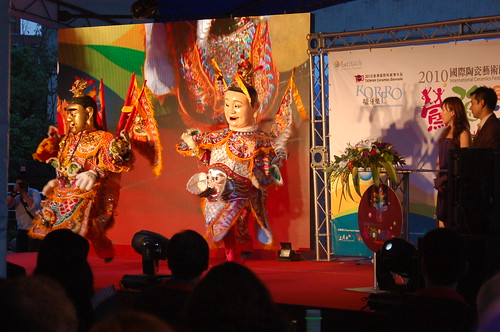 |
| Techno-Dancing traditional Chinese characters at the opening cerimonies |
The opening ceremonies of the Biennale and the Ceramics Festival, “Happy Clay Party,” pulled out all the stops. Mascot-like traditional Chinese drama characters preformed to techno-music as the opening entertainment on a stage under a huge white tent. Cocktails, coffee and tea were served, western-catering-company-style while important government officials, Moyra, and other special guests made short, eloquent and celebratory speeches. A very handsome couple with game-show-host personalities acted as the announcers for the evening, speaking every word into the microphone with a rising tone of elation accompanied by Ken-and-Barbie smiles. The YCM is also celebrating its ten year birthday, so to officially open the events and celebrate this milestone, all the special guests and executive staff of the museum climbed on stage together in front of a huge, layered, clay cake and placed colorful ceramic figurines with candles onto the slip-covered confection.
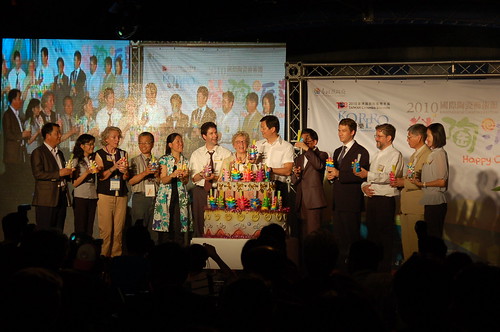 |
| Special Guests, Artists, and Museum Staff celebrate YCM's 10 year anniversary as part of the Biennale and Ceramic Festival opening celebration |
Some version of this happened at every important opening at YCM. Two other small shows, a crystalline glaze exhibition and a retrospective of Taiwanese ceramics are also currently on display in the museum, and at one of their openings, all the important guests in attendance poured slip into a mold as the act of commencement. During a press conference held in Taipei about two weeks before this opening festival, even I was invited on stage to participate in the ceremonial commencement act: signing and drawing a picture on a huge bisque-fired clay vase with kids’ coloring chalk. I was floored by the energy, enthusiasm, and spectacle that are these opening events of the Biennale and Clay Festival. The YCM is a very important organization because it is a major source of cultural education for Taipei County, thus deserving of national and international attention and participation during the opening events and for the duration of the exhibition and festival. I am amazed that so much hype about clay can exist, but at the same time, I am thinking, “Well, duh, of course its that awesome!” Although I was not one of the artists whose work was part of the Biennale exhibition, being invited to participate in all the events surrounding it, gave me an opportunity to be on part of the “in” crowd with an outside, objective eye. More importantly, it gave me a stronger sense of place and community within my chosen field, reinforcing the idea that working in clay as an artistic endeavor is part of a global tradition that has had an immeasurable bearing on understanding humanity, socially, historically, and culturally. The Korero-s, or conversations that ebbed and flowed during this opening weekend did not start here, nor will they end here or elsewhere. Clay is a medium that allows an infinite conversation spanning any topic or consideration. Exemplifying this is the goal of Moyra’s curatorial effort for the 2010 Biennale and she puts it best by quoting Ralph Waldo Emerson, “In conversation, the game is to say something new with old words.” The best part about this being an exhibition of ceramic art, which I can say with full conviction now that I have lived in Asia, is that with clay we can say something new with old earths, and there's no translation required when it comes to the actual, visual dynamic of the artwork.
I’ve only begun to tell you about my experience during this event. My experience during the Biennale Symposium, that asks, “Is international competition dead, but not yet lying down?” is probably another 2,000 words. So, this will have to be named Part I, and I’ll end with a bold-faced
TO BE CONTINUED . . .
Check out more photos on my Flickr page!
